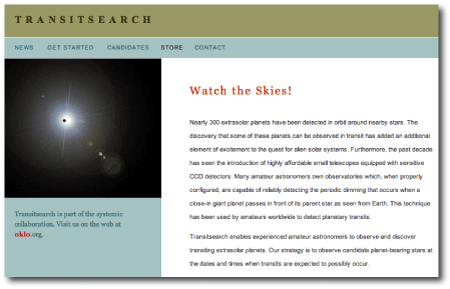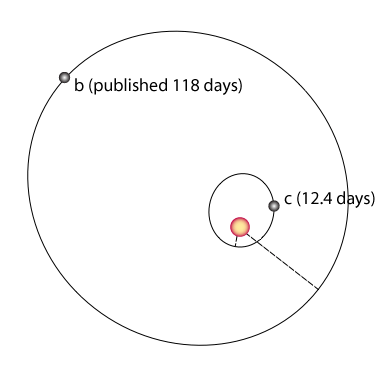
Image Source.
The Transitsearch collaboration has been active since 2001, and has fallen somewhat short of success. When reporters from the likes of space dot com call, they always want to know, “How many planets have you guys discovered?”
“Zero.”
The project has, however, been of some value. It’s helped publicize the fact that small telescopes can be of remarkable utility in carrying out photometric follow-up observerations. The basic strategy of checking Doppler-detected planets at the predicted transit times has proved its worth for the Swiss with the transits of Gl 436 b. But the fact is unavoidable. Transitsearch needs to step up several levels if it’s going to compete.
I’m thus in the midst of implementing a major overhaul of the site resources. To get away from the tonight-we’re-gonna-html like it’s 1999 feel, I’ve given the website a new look. Check it out.

Not everything is in place yet, but the server that hosts the systemic backend is now also keeping the candidates tables up to date. The ephemerides are incrementally updated every ten minutes, and so the transit window column now has a much finer resolution. It gives a quick overview of which planets are transiting (or potentially transiting) right now.
A Transitsearch observer seeking to get a first detection of a transiting extrasolar planet still starts at a major disadvantage. The radial velocity survey teams all have in-house photometric observers who monitor their candidate stars prior to announcement, and they thus have first dibs on the stars that are most likely to pan out with transits. This vertically integrated strategy will continue to monopolize the detection of hot Jupiters like HD 209458b, HD 149026b, and HD 189733b that transit bright stars.
Ideally, we need to get an open-source dedicated radial velocity observatory up and running to really feed transitsearch and the systemic backend, and we are looking at avenues to make this happen. In the interim, however, we can tap the growing fit database on the systemic backend for suitable candidate planets that have not yet been published in the literature. There are a number of planetary candidates that have low false-alarm probabilities and are dynamically stable (see also here).
To get things started, I’ve taken two candidate planets — HD 19994 c and HD 216770 c — from the probable planet discoveries page on the backend wiki, and reproduced the fits on the downloadable console. With a fit in hand, it’s straightforward to use the bootstrap utility to compute errors on the orbital parameters, and to produce transit ephemerides and observing windows. These first two candidates are listed in a table on the Transitsearch website, and we’ll be adding many more potential planets in the near future:

HD 216770 “c”, for example, has a period of 12.456 +/- 0.019 days, and Msin(i)~60 Earth Masses. If it exists, it has a 3.1% chance of transiting, and would likely produce a transit depth of a bit more than 1%. The radial velocity data set for HD 216770 is several years old, and so the transit window has, frustratingly, widened to about 8 days.

Let’s try to identify additional candidates that are (1) dynamically stable, (2) have Msin(i)>0.05 Jupiter Masses, (3) F-test statistics below 0.2, and (4) periods less than 100 days. If you find them, add them to the backend wiki, or as comments to this post.

Congratulations Greg.
That’s a very good job you have done on the website.
Transitsearch.org is worth reviving.
Regards
Joao Gregorio
aka Gregas
Pingback: Centauri Dreams » Blog Archive » Transitsearch Ups the Ante
Very professional looking, Greg. Much better, I think, than the old Transitsearch.org site. Well done!
best,
Eric
Very nice Greg, I also get the impression that there are a number of additional candidates that were not on the older version, true ?
Best,
David